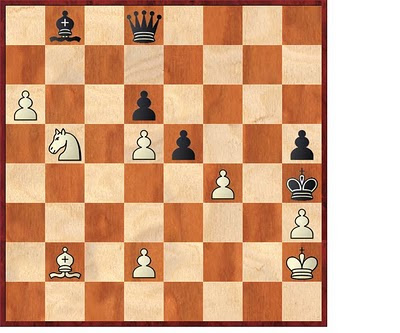
Players: Sagar Shah v/s IM Saptarshi Roy.
Position from 2011 Parsvnath tournament.
During a game its very important to be aware of your tactical possibilities. Where you have a superior position it is all the more important to be fully concentrated because the chances of a tactical shot are very high.
In the above position which i reached against IM Saptarshi Roy, it should be clear even to a beginner that white is clearly better. But there is an instant tactical win.
1.Qh7!! threatening the very simple Rd7 and surprisingly black is falling short of moves. 1...Rge8 (of course Nb6 is a terrible move because after 2.Rd8 Rd8 3.Rd8 Kd8 4.Bf6 Kc8 5.Qg8 Kc7 6.Qd8# is a pretty mate!)
2.Qg6! keeping an eye on the e8 rook and again threatening Rd7. 2...Nb6 (the most beautiful idea occurs after 2...Rg8 (2..e5 loses to 3.Rd6) 3.Qf7! and the B and the Q combine to take away all the squares from the rook and black loses an exchange.)
3.Rd8 Rd8 4.Rd8 Kd8 and i guess there is no need to see any further. this position is completely winning due to the h pawn but it is nice to see a move ahead and come to the conclusion that white not only has a positional advantage but also material advantage. 5.Bf6 Kc7 6.Qg3 and black has nothing better than to sacrifice a pawn with 6...e5 and after 7.Qe5+- white has a crushing advantage.
Whenever you have a winning position always be on the look out for tactical possibilities because some great player had once said, "Tactics stem from Superior positions!"
It is very embarassing but i have to say that i lost the above position in my game after i continued with 1.h4 but please do not try losing this position at home. It can be highly dangerous!








